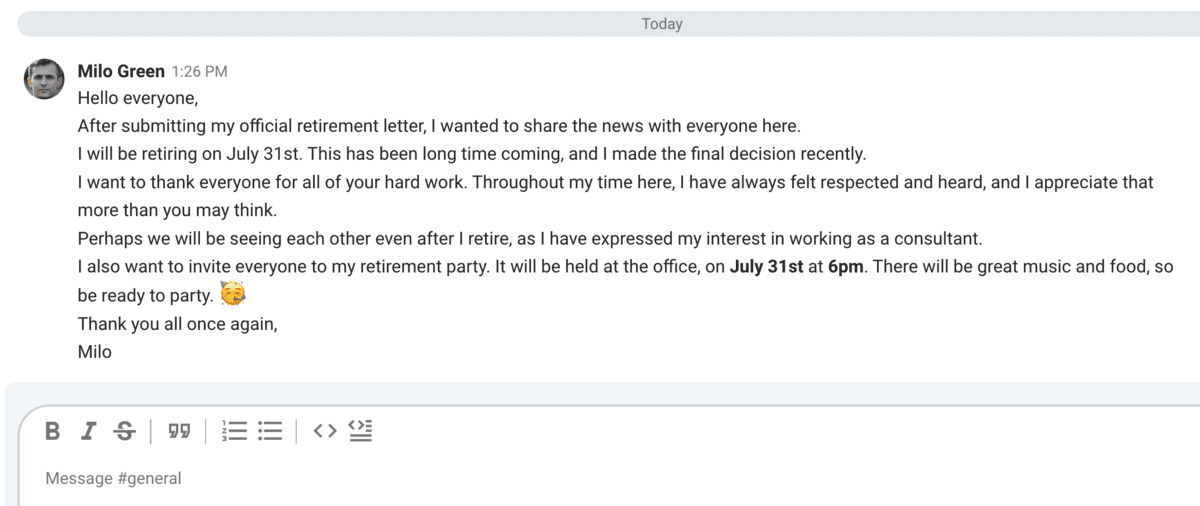Are you planning to retire? You may be wondering what are some of the steps you need to take. One of the first is certainly to inform your employer.
Around 10,000 people retire each day in the USA, according to data.
So, how do you break your retirement news to your team?
Writing a retirement letter is a good option.
It’s usually not a requirement, but it is a polite and professional thing to do before you part ways with your company. If you’re not sure how to write a retirement letter, this blog post is for you.
In this blog post, we will go over:
- What is a retirement letter,
- Why you should write one,
- Steps for writing a retirement letter, and
- Additional tips.
Also, we included examples of professional retirement letters you can use for inspiration.
Let’s start.

Table of Contents
Why should you write a retirement letter?
A retirement letter is an official document that provides notification of leaving a job to retire and a request for retirement benefits.
Writing a retirement letter is usually not obligatory. However, there are a few reasons why you should write one when you’re planning to retire.
Firstly, it’s considered a professional courtesy to inform your employer on time of your plans to retire.
It’s fair to say that if you’re planning to retire, you are probably highly skilled at what you do. Therefore, your company needs to start planning for a replacement in advance. They need to put up job listings, interview people, and choose a fitting replacement for when you retire. Giving your employer enough time to do these things is a professional thing to do.
Also, your company needs to figure out the legal details of your retirement plan.
Are you going to have healthcare? Do you have unused paid time off that you need to use up before you retire? Will your company be funding your pension?
These are all things that need to be taken care of before you retire, and it takes time.
Lastly, your coworkers might want to throw you a retirement party.
If you’ve been working for the same company for a long time, or you work in a close-knit team, it’s possible you’ll have a farewell party.
You should give your team enough time to prepare and plan your party, so be sure to send your letter on time.
There are multiple reasons why writing a retirement letter is important, so when in doubt — write one.
6 Steps for writing a retirement letter
Now that you’re aware of the importance of writing a retirement letter, let’s look at the key elements and steps you need to take when writing one.
Here’s what Leigh James, Head of HR at Page One Formula, has to say about the most important elements of a retirement letter:

“The most important elements to include in a retirement letter are the following:
- A formal statement of your intention to retire,
- An expression of gratitude for the years you have worked with the company,
- Start and end dates for your position, and
- Contact information for follow-up questions.”
Let’s look at the steps for writing a retirement letter.
Step #1: Choose the addressees
First, think about who needs to receive this letter.
Make sure to address it to all the relevant people. This can include but is not limited to:
- Direct supervisor,
- Human resources,
- CEO, and
- Your team.
It’s important to address your letter to everyone who needs to know about your plans. Think about everyone in your organization who will be affected by your retirement, and add them to the list.
Depending on the situation, you can hand in a physical copy to your direct supervisor, and email the letter to the rest.
Step #2: Consider a suitable header
After carefully addressing your letter, start off with a header.
Here you can include all the necessary information about yourself, such as:
- Name,
- Position,
- Address,
- Phone number, and
- Email address.
The header is a standard part of any letter, so there’s no need to do anything more in this step.
After the header, comes the main body of the letter.
Step #3: Specify a date of retirement
The most important fact that needs to be included in your retirement letter is the date of your retirement.
Make this the opening paragraph of your letter. Clearly state your intention to retire and include the exact date of your last day at the company.
Here’s how that can go:
“I am writing to inform you of my upcoming retirement. I will be retiring on [date].”
This way, you avoid any confusion and get straight to the point of your letter. Also, the reader of the letter will understand the intention behind it right away.
This is the main point of your letter, so put it to the forefront and make it clear.
Step #4: Show your appreciation
Another important element of a retirement letter is appreciation.
You should thank your employer for the opportunity to work with them. Also, show gratitude for the experiences and opportunities your job has given you.
If applicable, it would be a nice touch to point out specific projects that were memorable to you.
Furthermore, you can name a few people who have had the most impact on your career and thank them separately. Your coworkers will appreciate the personal touch.
Showing your gratitude and appreciation will show how much you care about your team so make sure you include it in your letter.
💡 Pumble Pro Tip
You’re aware that thanking your coworkers is important in the workplace, but have you ever wondered what to say back when someone says “Thank you”? Check out this blog post to find out alternative ways to say “You’re welcome”:
Step #5: Offer to assist with a new employee
If you know that your company will be hiring a replacement for you, you can offer some help.
Express your willingness to help with hiring or training new employees. If you are in a leadership position, or you will be leaving important projects unfinished, this step is essential.
You can outline the timeframe in which you will be able to help with new employees. For example, if you’re willing to stay on board for 4 weeks after your retirement to help with new employees, state that directly.
Here’s how you can put this:
“I would be more than happy to help with the transition period following my retirement. I’m willing to stay for 4 weeks after the date of my retirement to train the new employee. Feel free to reach out if this is needed.”
This will let your employer know you care about the company and its future progress.
Step #6: End with a closing statement
At the end of your letter, include a closing statement.
This can be in the form of a thank you note, followed by well wishes for the company.
Here’s an example of a closing statement:
“I would like to thank you once again for the opportunity to work with [company name]. I wish you all the best.”
After that simple closing statement, follow it up with your name, and you’re done.
Retirement letter examples
After going over the steps for writing retirement letters, let’s look at some examples.
You can use these examples as inspiration for your retirement letter or copy them and change relevant information as it suits you.
Example #1
Here’s our first example of a retirement letter:
“Dear [recipient’s name],
I’m writing to announce my upcoming retirement. My last day in the company will be [date].
I want to express my sincere appreciation for everything this company has offered me during my career. My position as [your position] has helped me grow and learn so much, and I’m deeply thankful for that.
I also want to thank everyone who worked alongside me for these [number] years. I would like to especially thank my team who have pushed me to achieve beyond what I thought I was capable of.
I’m happy to help in any way with the recruiting or training of a replacement employee.
Feel free to reach out with any questions or concerns,
Sincerely,
[your name].”
Example #2
Here’s another example:
“Dear [recipent’s name],
This letter serves as my official notice of retirement from [company name]. I will be retiring on [date].
My time with [company name] has opened so many opportunities for me. I want to thank each and every one of you for everything you’ve done for me for the past [number] years. I was so fortunate to have the best team around me. I’m so proud to reflect on our success over the years. I’m especially proud of our [specific project].
This is a bittersweet moment for me, as I’m sad to leave you behind, but I’m excited for this next chapter in my life. I will be prioritizing time with family in the coming years.
Thank you again for all the good memories.
Yours truly,
[your name].”
Example #3
Here’s an example of someone who’s retiring due to health reasons:
“Dear [recipient’s name],
I am submitting this letter as my official notice of retirement from [company name], effective [date].
It is with a heavy heart that I write this letter. I have spent [number] years at [company name], but it is now time for me to take the next step.
I want to express my gratitude to everyone I’ve worked with all these years. We’ve accomplished so much together. Special thanks to [certain person], who has guided me to become the best version of myself.
Unfortunately, due to health problems, retirement was the only option for me. I would also like to thank everyone for their well wishes and understanding during this difficult time.
In the upcoming years, I plan on focusing on my health, as well as quality time with loved ones.
For any questions, please feel free to contact me.
Sincerely,
[your name].”
Example #4
Take a look at another example here:
“Dear [recipient’s name],
Consider this my official letter of retirement. I will be retiring on [date].
I have come to this decision after careful consideration, and I feel this is the right step for me.
I would like to express my appreciation for [company name]. You have always treated me with respect and I have learned so much during my time here.
I’m especially proud of [project]. I couldn’t have done this without my team. Therefore, I would like to thank my team for their constant support and hard work.
I would also like to note that I am interested in continuing our relationship on a part-time or consulting basis after retirement.
Last but not least, my retirement party is scheduled for [date] at [time]. It’s a dinner party at [location], so dress up and be ready for a party.
For any questions or concerns, feel free to contact me.
Sincerely,
[your name].”
Example #5
Here’s how you can inform your coworkers of your retirement via a business messaging app:

This example is a little less formal than the others. If you work in an environment where informal communication is the norm, you can be less formal with your retirement announcement.
However, it’s worth asking if you need to submit a formal retirement letter as well.
10 Tips for writing retirement letters
The examples above give you an idea of what your retirement letter is supposed to look like.
We have some additional tips which will help you write a professional letter in no time.
Our contributor, Leigh James, adds:

“Think of the retirement letter as something more than a formality. It’s an opportunity to thank those you have worked with, reflect on your time at the company and foster relationships with colleagues. Remember that your letter should be polite, respectful, and professional.”
Tip #1: Be polite and professional
Your retirement letter is no different than any other professional letter. It’s an example of formal communication. So, always stay polite and professional.
Use appropriate language and respectfully address your readers. Maintain a positive and polite tone throughout your letter.
You want people to remember you as a great professional even after you retire, so make the last impression count.
Tip #2: Consider the delivery method
Although it’s generally best to hand in your retirement letter yourself, there are a few other ways you can do it.
Some companies like to have electronic copies of retirement letters, so you may need to send it by email.
On the other hand, newer generations usually prefer more informal communication methods, such as business communication apps. If it’s appropriate for your situation, you can send your letter via the app.
In any case, it’s probably best to hand in your retirement letter in physical form as well.
💡 Pumble Pro Tip
If you work in a multigenerational company, here’s how you can improve communication between different generations:
Tip #3: Go over your history at the company
Reflecting on your history in the company is not a necessary element of a good retirement letter. However, it can be heartwarming to the reader to look over your accomplishments. You shouldn’t spend too much time talking about the past but do mention some of your best work.
Highlight your career accomplishments by writing about your most important and successful projects.
You can also mention coworkers who have helped you the most throughout your career or highlight certain teams who made your life easier. This is a good moment to give praise to those who helped you accomplish your goals.
Look back at your career and all you have learned and accomplished, and share it with your coworkers.
Tip #4: Offer consulting or freelance work
If you want to continue your career after formal retirement, you may be interested in consulting work or a part-time position.
Make sure to let your employer know that you are interested in this kind of work after retirement.
Be clear about your limitations and expectations. For example, if you would be willing to work a 20-hour week, state it directly. Or if you would love to work as a consultant, bring it up in your letter.
Here’s how you can say that:
“I’m open to part-time or consulting positions after I retire. If the need arises, feel free to contact me and I will be more than happy to come back to the team in this capacity.”
This ensures that you are their top priority if a position like this opens up.
Tip #5: Pay attention to notice
You probably know well in advance when you’ll be retiring. It’s beneficial for your employer to know this as well.
Therefore, make sure to inform your company on time. That notice period depends on your country, state, or company rules.
Generally speaking, you should send your retirement letter at least 2-3 months in advance.
If you’re in a leadership position or any other very important position, think about sending your letter 6 months before your retirement date.
In some industries, up to a year’s notice is standard practice.
Think about your company and the vacant position after you leave and decide the appropriate time you should send your retirement letter.
Tip #6: Proofread your letter
Just like you do with every piece of writing, you should proofread your retirement letter.
Read your letter carefully to make sure there are no errors. Also, double-check that you’ve included all the necessary information in your letter.
Confusing sentences, typos, and similar mistakes make you look unprofessional.
Therefore, make sure you proofread your letter carefully before sending it.
Tip #7: Meet in person
Before sending your retirement letter, it’s a good idea to have a face-to-face meeting with your supervisor.
Discussing your retirement plan with your employer will kick off your retirement process and make it smoother.
You can discuss all of the important facts about your retirement, such as:
- Date of retirement,
- Plans after retirement,
- Part-time or consultant work, and
- Needs after retirement.
This will make it easier for you to send your retirement letter, as you have already agreed on the details with your employer. Also, your company will have ample time to plan what to do after you retire.
Therefore, if possible, discuss your retirement plans with your employer in person ahead of time.
Tip #8: Specify needs after retirement
It’s best to have a conversation in person with your employer about your benefits in retirement. You can discuss and agree on benefits such as:
- Healthcare,
- Pension,
- Unused vacation, and
- Unused sick days.
However, since it’s not always possible to have this discussion in person, you can include these points in your retirement letter.
Just make sure that you express openness to discussing details later on.
Tip #9: Share plans for retirement
Sharing your plans for retirement is another element of a retirement plan that is not mandatory, but it is nice.
If you’re close with your team, you may want to share your personal retirement plans. Do you want to move abroad? Are you picking up a new hobby? Or do you plan on spending as much time as you can with your family when you retire?
You can include these plans in your retirement letter to let your coworkers know what’s next for you.
Tip #10: Share retirement party details
If you are planning a retirement party before you leave, your retirement letter is an easy way to let everyone know.
Make sure you include all the necessary information for the attendees, such as:
- Location,
- Time,
- Dress code, and
- RSVP details.
This way, you can invite everyone and make sure they get the details on time.
Reflect on your career and share over Pumble
Retirement letters are a great way to start off your path to retirement.
You get to look back at everything you have accomplished in your career, as well as share these memories with people you’ve worked with.
If your team uses Pumble, a team communication and collaboration app, you’ll be able to easily share your retirement letter with all those coworkers you’ve appreciated during your time in the company.
Just send them your letter via a direct message! And, thanks to the channel feature, you’ll even be able to share it with the entire company and have everyone send you off to retirement with well wishes!




